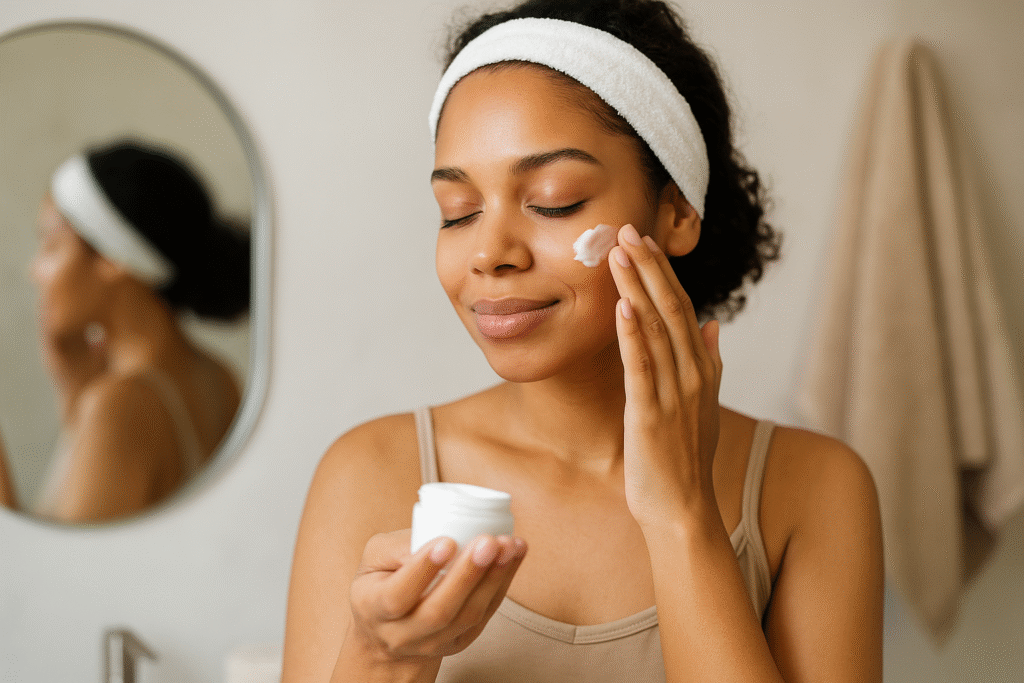Hyaluronic acid has taken the beauty world by storm, promising radiant, plump, and deeply hydrated skin. From serums and creams to injectables, this ingredient is everywhere. But with all the hype, one question remains: Does hyaluronic acid really work the way it claims?
In a world where skincare shelves are overflowing with miracle solutions, it’s easy to get lost in the marketing jargon. This article aims to cut through the noise and dive into the real science behind hyaluronic acid. We’ll explore its role in hydration, its ability to plump the skin, common misconceptions, and how to best incorporate it into your routine.
Whether you’re dealing with dry patches, fine lines, or just curious about this trending ingredient, this guide will give you everything you need to know. Let’s uncover the truth behind the hydration powerhouse known as hyaluronic acid.
The Science Behind Hyaluronic Acid
What Exactly Is Hyaluronic Acid?
Hyaluronic acid (HA) is a naturally occurring polysaccharide found throughout the human body, particularly in the skin, connective tissue, and eyes. It functions as a powerful humectant — a substance that draws and retains moisture. One gram of hyaluronic acid can hold up to six liters of water, making it essential for maintaining skin hydration and elasticity.
In skincare, HA is used in topical products, serums, moisturizers, and injectables due to its impressive moisture-binding capacity. However, not all hyaluronic acid molecules are the same — the size (or molecular weight) significantly affects its ability to penetrate the skin.
How Does It Work in the Skin?
Hyaluronic acid works primarily by binding water to skin cells. When applied topically, it sits on the skin’s surface or, depending on its molecular size, penetrates into the epidermis. Low molecular weight HA can reach deeper layers, helping to plump fine lines from within, while high molecular weight HA forms a moisture-sealing film on the surface. According to a Healthline article, these varying molecular weights are key to delivering hydration across multiple layers of the skin.
📌 Did You Know?
HA levels in the skin decline with age and UV exposure, contributing to dryness and loss of firmness. This is why HA-based skincare can help restore a youthful glow.
Natural Production vs. Topical Application
The human body naturally synthesizes hyaluronic acid, but this process slows with age. As production decreases, skin loses moisture more easily, making it more prone to wrinkles and dullness. Applying HA topically or receiving HA injections helps to temporarily replenish moisture and improve appearance, though it doesn’t stimulate new collagen or elastin on its own.
Visual Reference: HA Molecular Size Comparison
| Type of Hyaluronic Acid | Molecular Weight | Skin Penetration | Function |
|---|---|---|---|
| High Molecular Weight | >1,500 kDa | Stays on surface | Forms protective barrier |
| Medium Molecular Weight | 250–1,500 kDa | Shallow layers | Improves skin texture |
| Low Molecular Weight | <250 kDa | Deeper layers | Plumps from within |
Benefits and Efficacy of Hyaluronic Acid in Skincare
Deep Hydration for All Skin Types
Hyaluronic acid is celebrated for its ability to deliver intense hydration without clogging pores or leaving a greasy residue. Its lightweight texture makes it ideal for all skin types — from oily and acne-prone to dry and sensitive. By drawing moisture from the environment and binding it to the skin, HA helps maintain a healthy moisture barrier and enhances skin suppleness.
💡 Quick Tip
Apply HA products on damp skin to maximize water absorption and seal in hydration with a moisturizer.
Plumping Effect and Fine Line Reduction
One of the most visible benefits of HA is its temporary plumping effect. As it saturates the skin with moisture, it smooths out fine lines and improves overall texture. This is especially beneficial for areas prone to aging, like under the eyes and around the mouth. Though it doesn’t “fill” wrinkles like Botox or fillers, it does improve their appearance through hydration.
✅ Expert Summary
A 2011 study published in Dermatologic Therapy found that daily use of HA creams led to a significant reduction in wrinkle depth and increased skin firmness over 8 weeks.
Wound Healing and Barrier Repair
Beyond hydration, hyaluronic acid plays a role in skin repair and wound healing. It helps regulate inflammation, encourages tissue regeneration, and provides an optimal environment for healing. This is why it’s often included in post-procedure skincare, like after microneedling or chemical peels.
Visual Insight: Before and After Hydration
Image Suggestion: A side-by-side comparison of dehydrated skin vs. hydrated skin under a microscope, showing improved structure and plumpness post-HA application.
Common Myths and Misconceptions About Hyaluronic Acid
Myth #1: Hyaluronic Acid Is an Exfoliating Acid
Despite its name, hyaluronic acid is not an exfoliating acid like glycolic or salicylic acid. It doesn’t remove dead skin cells or affect skin turnover. Instead, it functions solely as a humectant — a moisture magnet. This misunderstanding often causes people to misuse the product or expect exfoliation benefits it simply doesn’t offer.
📌 Did You Know?
The “acid” in hyaluronic acid refers to its chemical structure, not its function on the skin.
Myth #2: More Hyaluronic Acid Means Better Results
Some believe that layering multiple HA products will enhance hydration, but more isn’t always better. Overuse can actually backfire, especially in dry climates. HA can pull water from the deeper layers of your skin if there’s not enough humidity in the air, potentially leading to even drier skin.
💡 Quick Tip
Always seal your HA serum with an occlusive moisturizer to prevent trans-epidermal water loss.
Myth #3: All HA Products Work the Same
Not all hyaluronic acid formulations are created equal. Some products use high molecular weight HA, which sits on the skin’s surface, while others include low molecular weight HA that penetrates deeper. Additionally, concentrations, pH levels, and supporting ingredients all influence how effective the product is.
✅ Expert Summary
A 2016 review in The Journal of Clinical and Aesthetic Dermatology emphasized that multi-weight HA formulas offer superior hydration by targeting different layers of the skin. Additionally, the National Institutes of Health (NIH) highlights hyaluronic acid’s role in wound repair, cell proliferation, and its impact on aging skin.
How to Use Hyaluronic Acid in Your Skincare Routine
Best Time and Method of Application
To maximize hyaluronic acid’s hydrating benefits, the timing and method of application matter. The ideal moment is right after cleansing, when your skin is still damp. This allows HA to bind the water on the surface and enhance moisture retention.
Application Steps:
- Cleanse your skin thoroughly.
- While your skin is still damp, apply 2–3 drops of HA serum.
- Immediately follow with a moisturizer or facial oil to seal in the hydration.
- Use morning and/or evening, depending on your routine.

💡 Quick Tip
If your environment is dry, consider using a humidifier or misting your face before applying HA for better absorption.
Combining HA With Other Ingredients
Hyaluronic acid plays well with most ingredients, making it versatile in any skincare routine. It works synergistically with:
- Vitamin C: Boosts brightness while HA hydrates.
- Retinol: Reduces irritation by maintaining moisture.
- Niacinamide: Improves barrier function and tone alongside hydration.
Avoid pairing it with drying alcohols or very acidic products in the same step, as these can counteract its effects.
HA in Layered Routines: What Goes Where
When layering multiple skincare products, follow the rule of texture — from thinnest to thickest. HA serums are typically lightweight and should be applied early, after cleansing and before thicker serums or creams.
Short Routine Example
Morning:
- Cleanser
- Hyaluronic Acid Serum
- Vitamin C Serum
- Moisturizer
- Sunscreen
Evening:
- Cleanser
- Toner (optional)
- Hyaluronic Acid Serum
- Retinol (if used)
- Night Cream
Expert Tips and Long-Term Use of Hyaluronic Acid
Advanced Strategies for Maximum Hydration
To fully leverage hyaluronic acid’s benefits, it’s important to pair it with lifestyle and environmental strategies:
- Hydration from within: Drink adequate water daily. HA relies on moisture availability to function.
- Use in humid environments: HA performs best when there’s moisture in the air.
- Pair with occlusives: Lock in hydration using ingredients like squalane, ceramides, or shea butter.
✅ Expert Summary
Dermatologists recommend using multi-molecular HA products and always sealing them in with a hydrating cream, especially at night.
What to Expect With Continued Use
With consistent use, most users report:
- Smoother, more supple skin
- Fewer dry patches
- Temporary plumping of fine lines
- Enhanced glow
Results are generally visible within 1–2 weeks, but long-term hydration and barrier support build up over 3–6 months of regular use.
📌 Did You Know?
Injectable forms of HA (like dermal fillers) can last 6–18 months and offer immediate plumping, but they serve a different purpose than topical HA.
How to Apply This to Your Routine

Daily and Weekly Skincare Routine With HA
Integrating hyaluronic acid into your routine doesn’t have to be complicated. Here’s a simple structure to follow:
Daily Routine (AM & PM):
- Step 1: Gentle cleanser
- Step 2: Apply HA serum to damp skin
- Step 3: Seal with a moisturizer
- Step 4: (AM only) Apply SPF 30+
Weekly Additions:
- Use a hydrating sheet mask with HA once or twice a week for an extra boost.
- Consider alternating with exfoliating acids on other nights to keep your skin balanced.
💡 Quick Tip
Layer HA under a sleeping mask at night for a hydration surge while you sleep.
Hydrating Skincare Recipe: HA Mist
DIY Hyaluronic Acid Facial Mist:
- 1 cup distilled water
- 1/4 tsp low molecular weight HA powder
- Optional: 2–3 drops of rose or chamomile essential oil
Mix and store in a spray bottle. Mist lightly before HA serum for enhanced absorption.
Checklist: Are You Using HA Correctly?
✅ Applying to damp skin
✅ Following with an occlusive moisturizer
✅ Using daily (morning or night)
✅ Combining with supportive ingredients (niacinamide, vitamin C)
✅ Avoiding overuse in dry air conditions
7-Day Mini Challenge: Hydration Reset
| Day | Morning Focus | Evening Focus | Your Notes |
|---|---|---|---|
| 1 | Cleanse + HA + SPF | HA + Moisturizer | |
| 2 | HA + Vitamin C Combo | HA + Retinol (if used) | |
| 3 | Mist + HA + SPF | Sheet Mask with HA | |
| 4 | HA + Niacinamide | HA + Moisturizer | |
| 5 | Exfoliate (AHA/BHA) | HA + Barrier Cream | |
| 6 | Hydration Mist + HA | HA + Night Cream | |
| 7 | HA + Full Routine | Mask + Massage + HA |
Conclusion
Hyaluronic acid is much more than a passing skincare trend — it’s a scientifically supported ingredient that delivers real hydration and visible improvement in skin texture and plumpness. While it may not erase wrinkles or replace in-office procedures, its ability to draw and retain moisture makes it a valuable tool in any skincare routine.
When used correctly and consistently, hyaluronic acid helps restore a youthful glow, support the skin barrier, and enhance the effects of other skincare ingredients. Whether you’re new to skincare or a seasoned enthusiast, incorporating HA can make a noticeable difference in your skin’s health and appearance.
Softly but surely, hyaluronic acid proves its place as a true hydration hero.
Main Takeaways
- Hyaluronic acid is a humectant that draws and binds water to the skin.
- Molecular weight matters — low weights penetrate, high weights seal.
- Best applied to damp skin and sealed with moisturizer.
- Works for all skin types, including sensitive and acne-prone.
- Consistent use leads to smoother, more hydrated skin in as little as 1–2 weeks.
- Combines well with actives like vitamin C, niacinamide, and retinol.
Further Reading
Want to take your skincare knowledge even further? Explore these expert-backed articles to elevate your glow and tackle aging naturally:
- 🔗 Collagen Boosters: What Really Works?
Uncover the truth about what actually improves collagen production — and what’s just hype. - 🔗 Natural Remedies for Wrinkles & Fine Lines
Learn proven, natural solutions to reduce visible signs of aging without harsh treatments.








One Response